


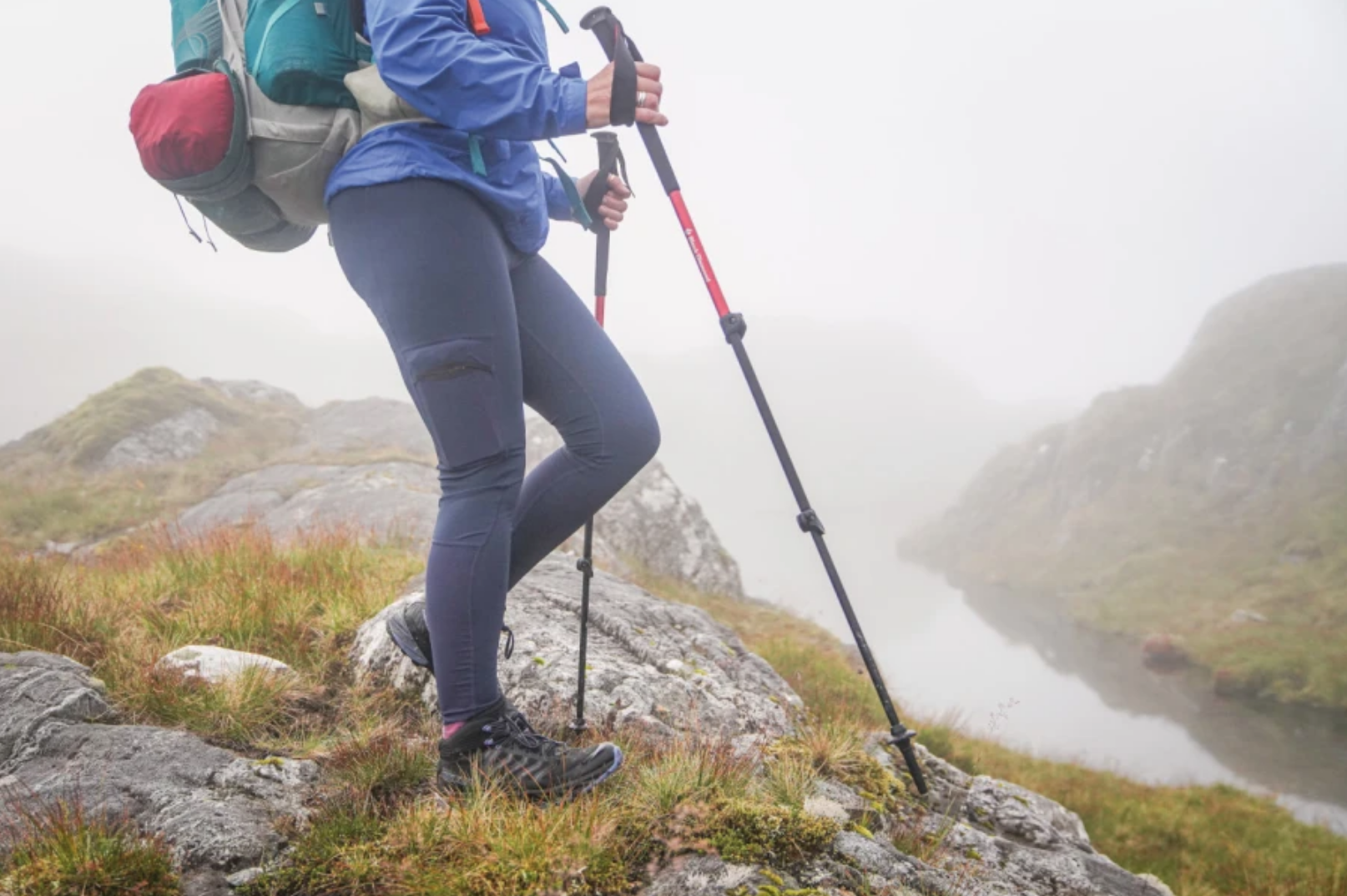
Trekking poles, also known as trekking sticks or hiking poles, help you balance, save energy and protect your joints. They also reduce the chance of hip, back, knee or ankle injury as they create at least two or three points of contact on the ground at any one time to help to spread out our weight. When carrying heavier or multi-day loads they will also ensure that the larger load is shared between lower and upper body.
Consider the difference between a path in your local park and a remote mountain. As the terrain becomes more uneven, the practicality of trekking poles increases. When the trail runs out and you need to go off-track, hiking poles can then help to support your whole body as you navigate the lumps and bumps and things like bogs and rivers. Hiking poles allow us to ‘feel out’ these slippery unknowns before we enter them, gain purchase and transfer weight carefully from one limb to the next.
Related: Best hiking boots reviewed
The same goes for snow and ice. That’s when poles provide extra security when crossing streams that are snow-covered and probing for weaknesses in the snowpack to prevent losing an ankle or worse to the abyss. Should the worst result and a limb needs to be ‘set’ in an accident, a trekking pole makes for an excellent splint – particularly if you wrap gaffer tape around the stem for emergencies. And for lightweight one-person tent or tarp users, they can even be used to hold up a shelter.
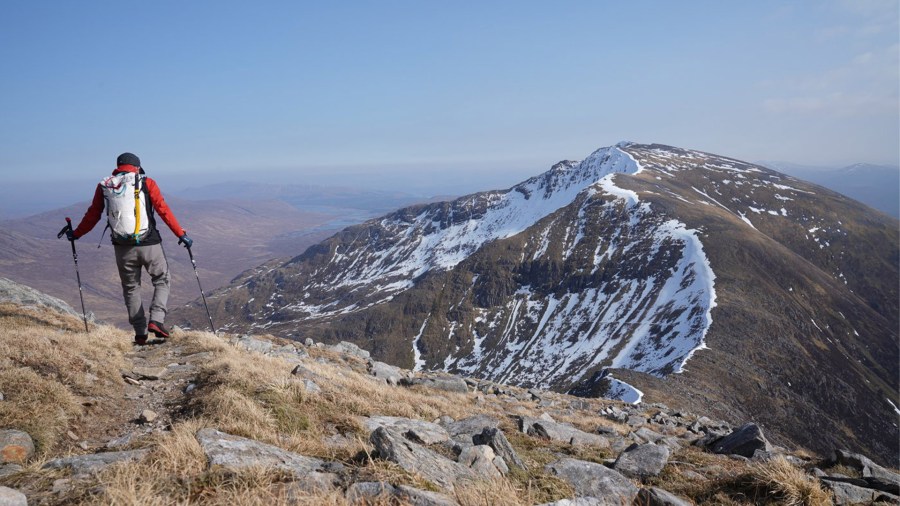
Using a pair of poles to descend. Photo: David Lintern
Modern trekking poles come in uniform pairs, are height adjustable and generally lightweight. They can be collapsed or folded away in transit, and have wrist straps. Here are some of the important aspects to consider when buying a pair of poles for hiking.
Materials – Most modern hiking poles are made from aluminium, which is reasonably environmentally friendly (around 75% of all aluminium is recycled) or, increasingly, carbon, which has a good strength-to-weight ratio. Shaft diameter as well as material will determine whether the pole is reliable in use and durable over the longer term.
Handle – Often made of foam or cork, these need to be grippy in all weathers and provide some insulation from the main pole shaft. Check that the grip will fit easily in your hand and that it extends some way down the upper shaft – it’s useful when contouring to quickly move your hand up and down the pole without altering its height.
Straps – Straps vary in design, from simple hoops that loop around the wrist to complex systems that are designed to improve leverage. Be cautious on very steep ground – breaks or sprains can result from being ‘tied in’ to poles in this way.
Locks – When not in use, trekking poles can be folded away or collapsed down to stow in or on a hiking backpack. The three most common connections are twist lock (a friction-based system), flick lock (hinge-based), or fold lock (by tension, which depends on the cord that runs down the length of the shaft internally). The latter often collapse smaller and more lightweight but are generally less durable and cannot be completely disassembled. The joints also allow the user to adjust the height of the pole. Check that the pole you purchase has enough height adjustment for your body height.
Baskets – Baskets stop the pole sinking into the ground. Some poles are supplied with two sets – a smaller trekking basket, and a much wider snow basket
for winter conditions.
Ferrule – The most common tip is a metal point, which provides excellent grip but can contribute to soil erosion in popular areas. Some poles are also supplied with a rubber foot that fits over the top of these points. which is fine for less technical terrain. When not in use, poles should always be transported on your pack with their points facing down. Mountain Rescue has plenty of grisly stories that show why.
This article highlights the results of extended trekking pole tests by our reviewer, David Lintern, with contributions from Will Renwick. The chosen nine have all been judged and selected for their performance, durability, reliability and value.

Materials: aluminium shaft, foam handle | Features: 3-section pole, fabric straps, flick lock system, 3-season and winter baskets supplied | Sizes: packed length 64cm, fully extended 140cm
The Black Diamond Trail is a tried and true trekking pole whose strength lies in its simplicity. It’s a 3-section aluminium pole with instantly readable measurements in metric given on the lower two sections, and a good range of height adjustability. The foam handle is well suited for medium-sized hands and comes in a single, long piece, with very basic moulding for the bottom of the palm. In combination with a reasonable price, the BD Trail gets my Best Buy.
Read our full Black Diamond Trail review
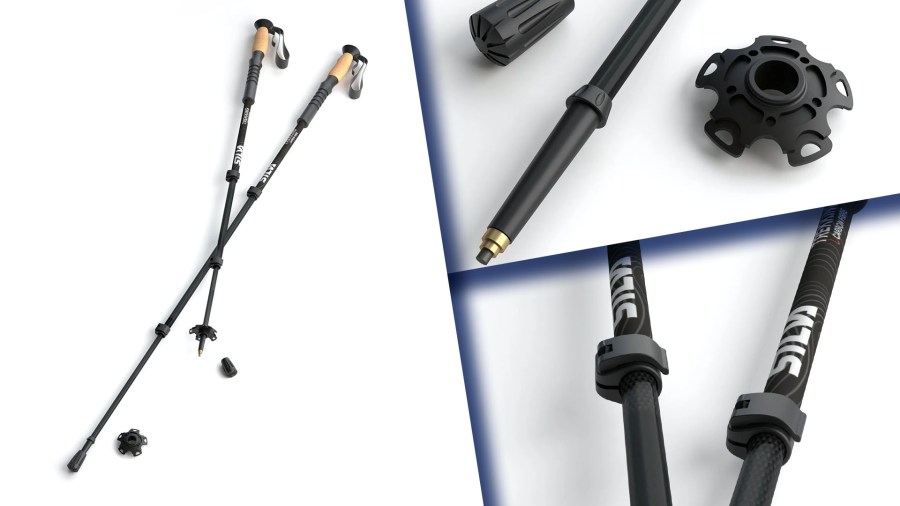
Materials: carbon shaft, cork handles | Features: cork handle, fabric strap, 3-section pole, winter basket and rubber feet supplied | Size: packed length 66cm, fully extended 140cm
Silva all-carbon poles are lightweight, comfortable to use and exceptionally robust. The handles are luxurious and provide excellent sweat management, but the grips are on the large size, even for my ‘size large’ hands. Thinner carbon poles tend to bend or wobble under strain, but these are well-made, wider-diameter shafts that have held a shelter up in high winds without complaint. In conclusion, there’s lot to recommend here, especially if you have big mitts.
Read our full Silva Trekking Poles Carbon review
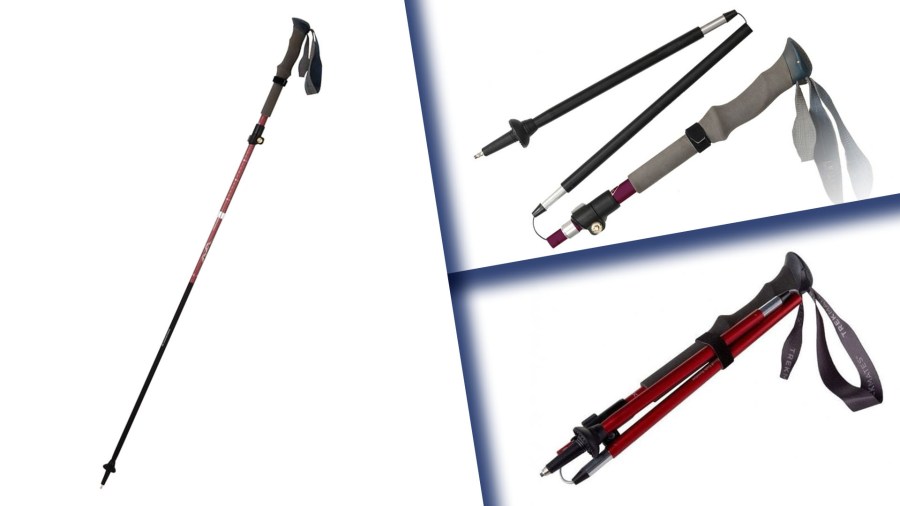
Materials: aluminium, foam handle | Features: 3-section pole, fabric strap, fold lock system with flick lock height adjuster, 3-season basket supplied. | Sizes: packed length 35cm, fully extended 125cm
The Trekmates are the budget option here and would be my personal choice of the two in this review that incorporate a folding lock system. It’s advertised as a five-section unit, but in practical use it’s four. The pole sections are ‘aircraft grade’ aluminium (marketing speak for ‘tough’?). and the unit is held together by a plastic-coated wire cord.
Read our full Trekmates Fold Lock review
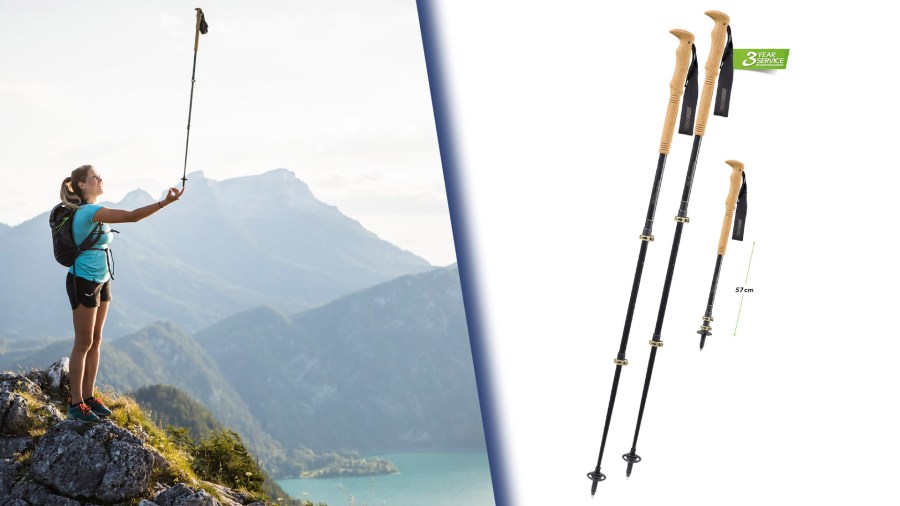
Materials: carbon shaft, aluminium locks, foam handle | Features: 3-section pole, fabric straps, flick lock system, 3-season baskets supplied. | Sizes: packed 57.5cm, fully extended 121cm
The Cloud Compact from Komperdell is the lightest pole in this test, but very tough and well-designed. It’s a three-section, all-carbon pole, with the sections being adjusted by flick locks. In use, the use of carbon throughout means the weight balance shifts towards the upper third of the pole, but they are so lightweight overall they are hard not to enjoy using.
Read our full Komperdell Carbon C3 Cloud Compact review
Available at: komperdell.com
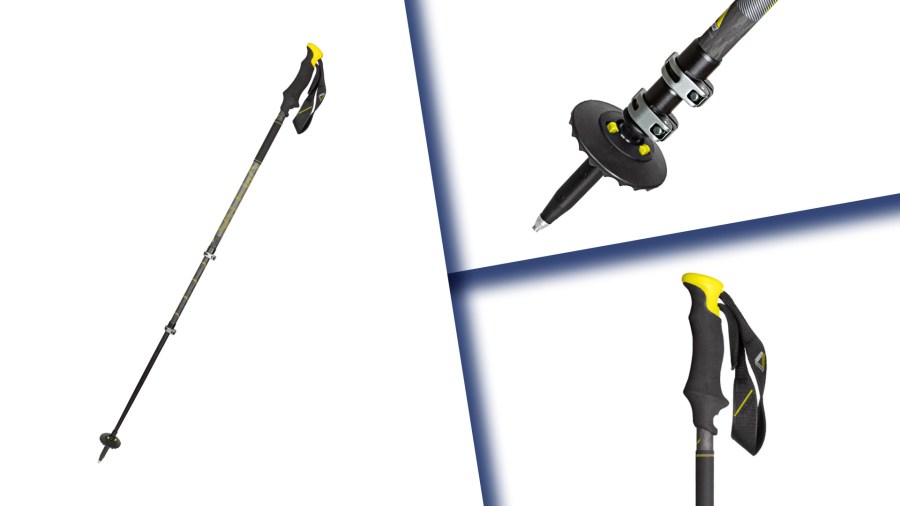
Materials: carbon (upper) and aluminium (lower) shafts, foam handle | Features: 3-section pole, fabric straps, foam handle, flick lock system, 3-season basket supplied. | Sizes: packed 68cm, fully extended 138.5cm
The Carbonium is a three-section, composite pole – the upper two are carbon and the lower third is aluminium. Each section is held together with flick locks, tensioned by recessed Phillips screw. In use, the poles proved secure and rigid, but the use of carbon in the upper sections and aluminium lower down means the pole feels unevenly weighted at the tip.
Read our full Salewa Carbonium Ascent Poles review
Available at: salewa.com
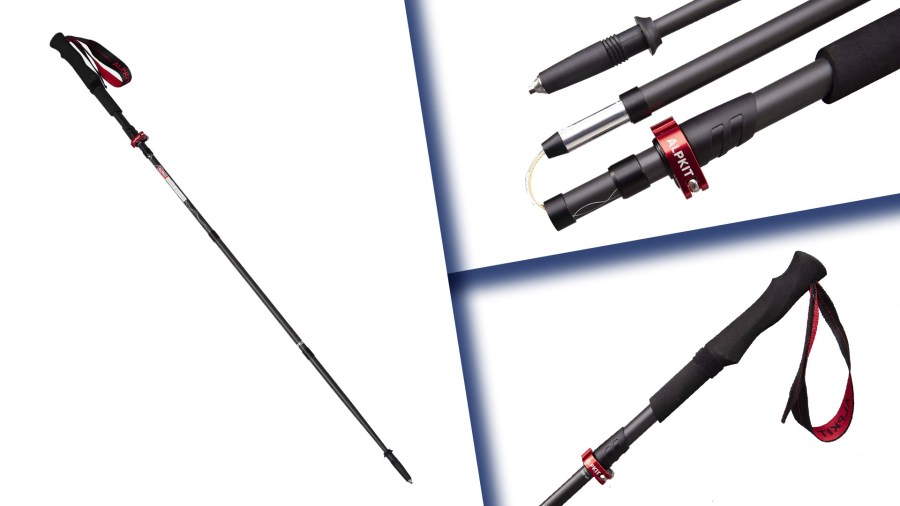
Materials: carbon, foam | Features: 3-section carbon, foam handle, fabric strap, fold lock with flick lock height adjuster, 3-season basket and rubber feet supplied | Sizes: packed 42cm, fully extended 130cm
All-carbon, five-section, folding lock-based pole that folds small and is quite lightweight. The sections go together easily, but the brass pin that holds the sections once assembled is prone to sticking. I’ve managed to field repair with a penknife each time. Sadly, in use the poles wobbled and bowed, and felt very insecure once off a groomed trail.
Read our full Alpkit Carbon Marathon review
Available at: alpkit.com
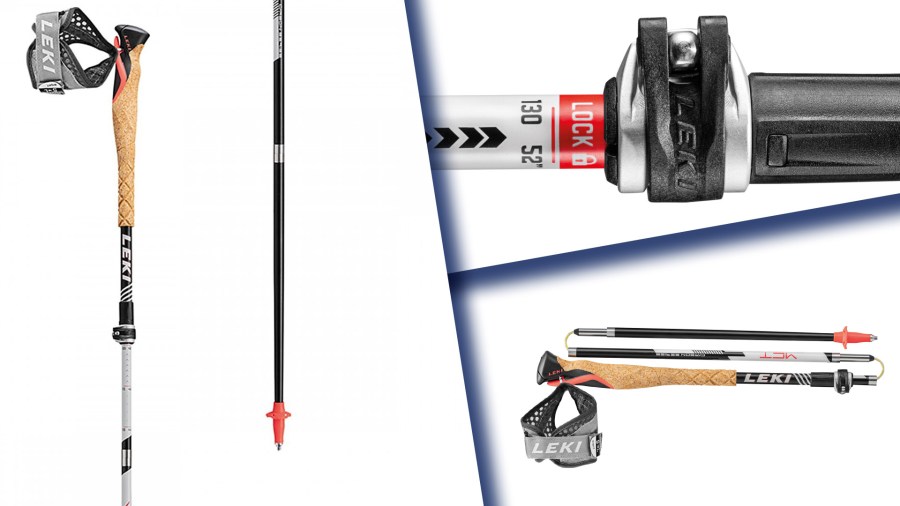
Materials: carbon Features: 3-section pole, fabric gloved straps, Speed lock system | Packed length: 42cm Size: 110 – 130cm.
This is an extremely lightweight trekking pole that’s very convenient for those who like to travel light on the trail. What’s particularly impressive, however, is the fact that it’s also very durable and dependable.
Leki are hiking pole-making experts and all the details here have therefore been nailed. Folding the pole and deploying it is quick and easy, height adjustment can be done in an instant and the handle is grippy and comfortable even when it’s wet.
Then there’s the impressive strap system which borrows from the same tech that’s seen in cross country skiing. This involves a wrist glove with a loop that clips onto the top of the pole, letting you swing the pole without having to grip tight to the handle – as a cross country skier would do.
Leki say this pole is made from cross trail activities. That means it’s suitable for both hiking and running, and we’d agree.
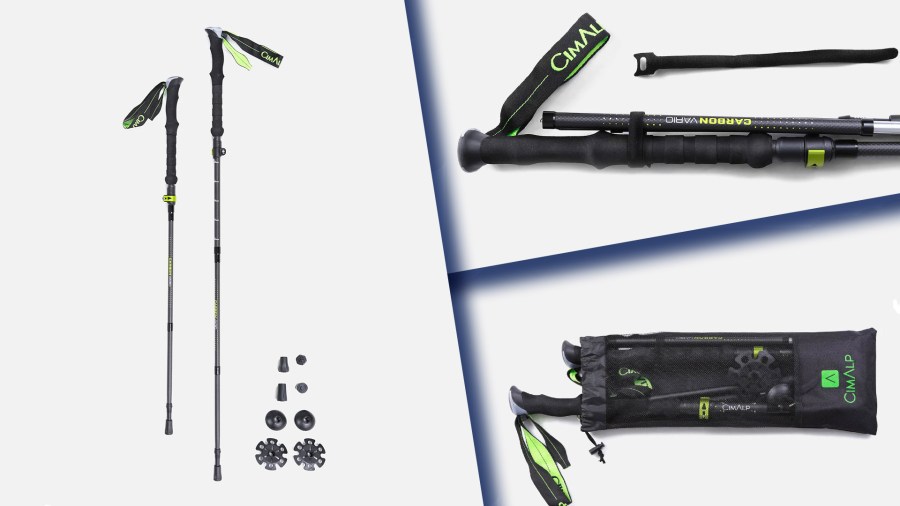
Materials: carbon Features: 3-section pole, fabric straps, easy-lock tightening system, snow baskets and nordic walking tip ends | Packed length: 36cm. Size: 110 – 130cm.
This is an excellent pole. It’s light, durable, practical, reliable and it’s also good value. CimAlp, in case you don’t know them, are very similar to Alpkit – they offer good products and sell them at good prices.
This pole is a z-folding one that’s quick to stash and deploy. There’s height adjustment, a comfortable handle that extends down the pole and various accessories that adapt the pole’s tip to suit different types of surfaces underfoot.
Handily, the Distance Carbon comes with a handy little mesh stash sack too.
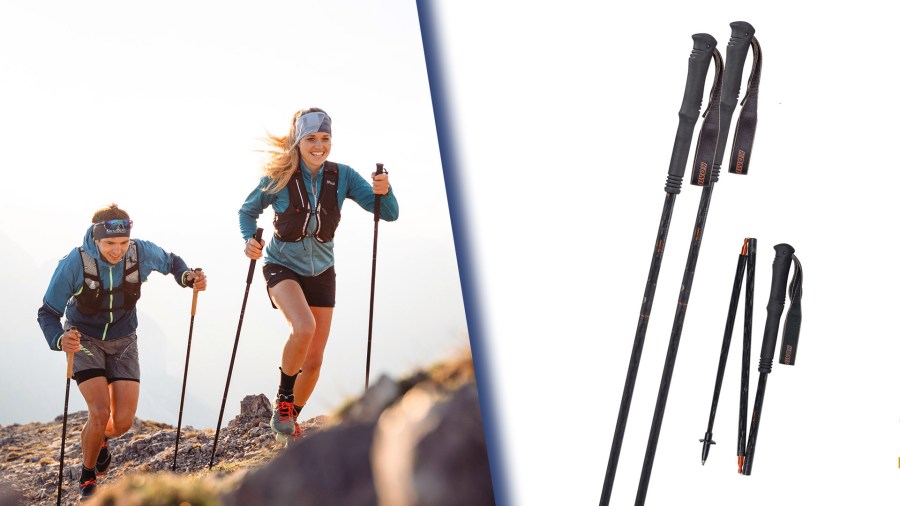
Materials: carbon composite Features: 3-section pole, foam handle, fabric strap | Packed length: 41cm. Size options: 105, 115, 125, 135 cm
This pole is made primarily for trail running but it’s certainly suitable for hiking too. The main thing to know about it is that it is self deploying; that means that it can snap from its bundled down form into a rigid rod in a split second. There’s a little Velcro strap to keep it from deploying when you don’t want it to deploy and when this is released it’ll quickly snap into shape, so care is required!
The Carbon Trail.FXP is remarkably light too, which is impressive given the unique technology Komperdell have implemented here.
It’s worth bearing in mind that this doesn’t have height adjustment, so you need to make sure you buy the right sized pole for you out of the four heights Komperdell offer.
Additional reviews added by Will Renwick 03/04/2023

